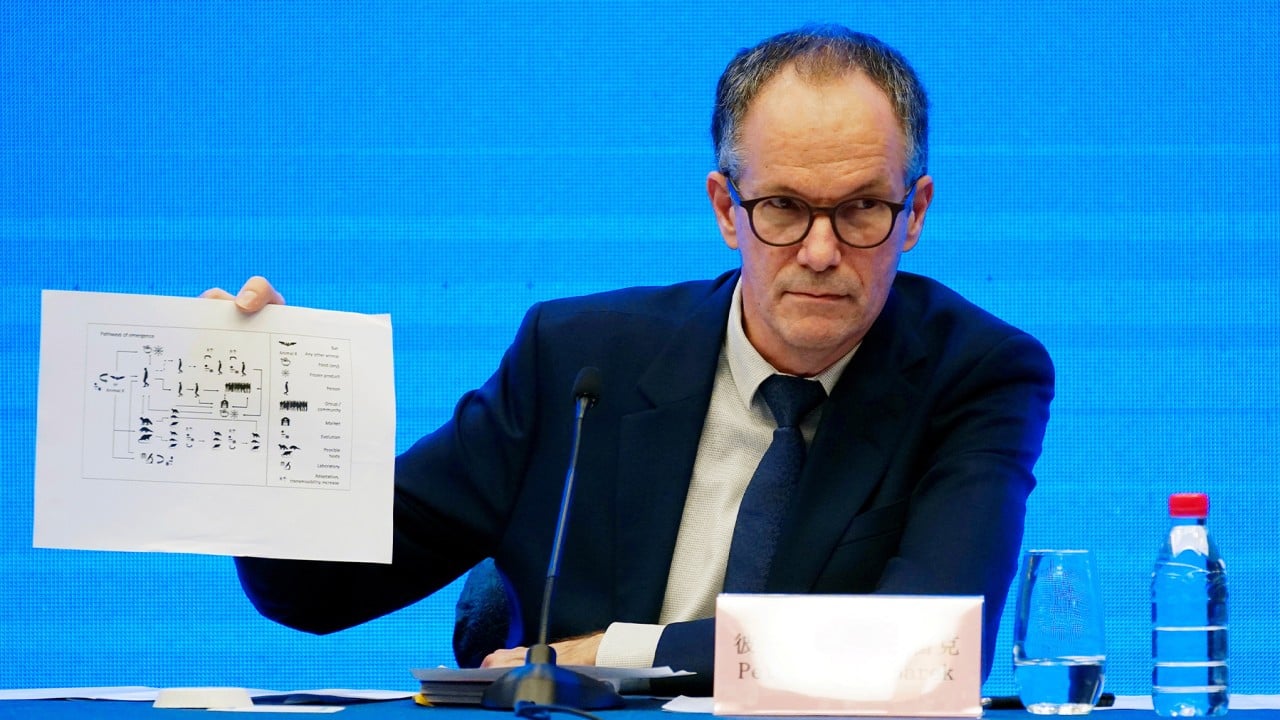
US-China tensions over ‘lab leak’ theory hamper hunt for Covid-19 origins
- Scientists call for less politics, more answers as multiple theories remain in play nearly two years after the virus emerged
- Failure of US intelligence report to pin pandemic on Wuhan laboratory will not make the debate go away, they fear
But medical and global health experts say the inconclusive findings highlight the need for more scientific research and transparency, as the clock ticks towards two years since the pathogen was thought to have begun spreading in people and multiple theories remain in play about how that happened.
“We should empower the WHO to allow this UN body to investigate on-site in any country, whenever it wants. We should first depoliticise this debate, which needs answers to questions for the sake of global security,” said Antoine Flahault, director of the Institute of Global Health at the University of Geneva.
“It is not the role of any intelligence services from the US nor from anywhere to embrace such issues,” he said, adding that China, which recently rebuffed a WHO plan for more research, had not been “mature”.
The Office of the Director of National Intelligence released a declassified summary of the report, delivered to Biden last week. The intelligence agencies did come to “broad agreement” that the virus was not developed as a biological weapon and that China’s officials did not have advance knowledge of the virus before the outbreak.
Most agencies also assessed “with low confidence” that the virus was “probably not genetically engineered” – addressing a debate that has centred around the genetic manipulation of viruses at the Wuhan Institute of Virology. Two agencies felt there was not enough data to make an assessment, according to the brief.
The agencies remained divided, however, over the key question: whether a virus could have emerged as the result of a person getting infected during a laboratory-associated incident, versus through natural contact with an infected animal – a scenario deemed more likely by the WHO-led team.

01:56
WHO ends Covid-19 mission in Wuhan, says lab leak ‘extremely unlikely’
“My read of this conclusion is that most observers thought the virus was of natural origin. The difference of opinion is whether it originated from a human infected in the community or an infected animal … versus a human infected in the laboratory, who then spread the virus,” said coronavirus specialist Stanley Perlman, a professor of microbiology and immunology at the University of Iowa in the US.
“These two possibilities are difficult to distinguish without much more data and transparency.”
David Robertson, head of viral genomics and bioinformatics at the University of Glasgow’s Centre for Virus Research, said he was surprised the intelligence community did not “dismiss the lab leak notion”, given there was “no evidence beyond speculation” linking the lab to the virus.
“The scientific evidence points to a naturally evolved virus so it’s good to see this confirmed by the intelligence community, who presumably have access to other types of data,” he added.
But Ayelet Berman, lead in global health and governance at the National University of Singapore’s Centre for International Law, said the “low confidence” reading on the assessment from most agencies, and a lack of decision from two, about genetic manipulation meant this question was “effectively unanswered in this report”.
Berman said this was also the case for the lab leak theory, given that elements in the intelligence community did not rule this out. “Whereas the previous WHO mission found that a lab incident was highly unlikely, these reports actually shift the needle with respect to the likelihood of this being a possible lab accident,” she said.
“What we can also understand from the report is that US intelligence is limited and that data is still missing – data that only the Chinese can get or already have access to. Thus, political pressure on China to cooperate and hand over data will persist.”
China has rebuffed a WHO vision for next-phase origins research, after the plan included audits of laboratories, which Beijing said it viewed as politically motivated. The WHO has also called on China to share more data from the early days of its outbreak, but Chinese health officials have denied a lack of transparency, saying raw data from early patients could not be shared due to patient confidentiality.
Beijing reacted to the US report with a raft of statements from officials and diplomats decrying the effort, including during a call between Foreign Minister Wang Yi and US Secretary of State Antony Blinken on Sunday. Wang blamed the US for “interfering with and undermining” scientific research into the origins of the virus by politicising the issue, according to the Chinese side’s readout of the call.
Some observers said the results did not appear to be damning for China.
Jin Dong-yan, a molecular virologist at the University of Hong Kong, said “it was quite critical that there is no credible evidence presented that the virus was a laboratory leak, man-made, or a bioweapon, in the whole [declassified] report … this is actually to [China’s] benefit”.
But Jin said for the world to advance its understanding of the pathogen it was necessary to gain more access to data, especially about the earliest cases in Wuhan.
“Even the intelligence report came to the same conclusion – if there is no cooperation from the Chinese side, then it’s almost impossible to solve this puzzle,” he said.
But others say that in the face of uncertainty, there could still be progress on reducing risks for the next outbreak.
“We need to move forward,” said Wanda Markotter, director of the Centre for Viral Zoonoses at the University of Pretoria in South Africa. “We need to focus on improving biosurveillance and addressing factors that may lead to spillover … I hope the focus of future conversations will be around this.”

